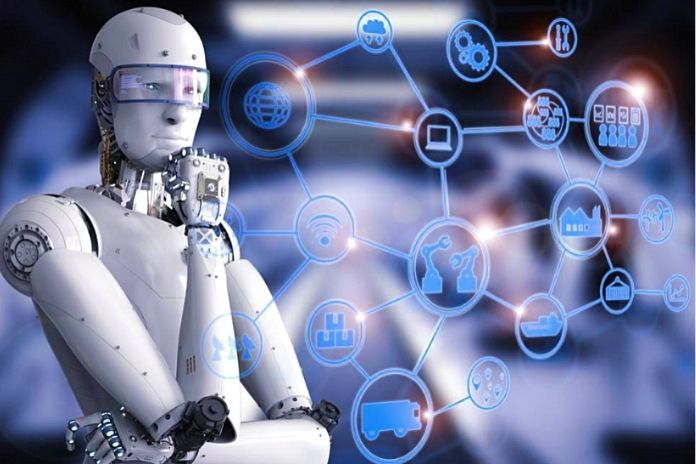Films like “WALL · E” or “I, Robot” describe a world where robots play a central role in people’s lives. They should mainly relieve people of annoying everyday tasks. The manufacturing industry shows that this dream is already partially a reality thanks to artificial intelligence (AI) and machine learning.
AI and machine learning are part of our everyday life these days. Be it in your own four walls with the virtual assistant Alexa or the countless voice assistants such as Siri on your mobile phone. But is that artificial intelligence? AI is understood to mean the ability to transfer intelligent human behavior to machines, such as recognizing text, image content, or speech recognition.
Although the terms AI and machine learning are often used interchangeably, they are not the same. Machine learning is only a sub-area of AI and describes mathematical techniques that enable a machine to generate knowledge from experience independently.
Robots In Production
When people talk about AI in the manufacturing industry, they usually mean intelligent industrial robots. Machine learning is one of the most powerful technologies for industrial robots. The aim is for the machine to learn from previous errors and to be able to identify future problems or malfunctions in good time and to resolve them independently.
The interest of companies in integrating these digital technologies into their manufacturing processes has risen sharply in recent years. According to a study by BCG and MIT Sloan Management , 84% of executives assume a clear competitive advantage through intelligent and intelligent machines.
In practice, the advantage is as follows: During product assembly, robots use sensors and cameras to reliably identify individual parts and pick, position and correctly assemble components of a community. Industrial robots are used mainly in production processes with highly automated movement sequences, such as laser welding, soldering, spraying, or gluing.
The robot-assisted inspection is also integrated directly into the production line. This is particularly useful for products with prominent form factors. Heavy parts can be welded together with programmed robot arms and thus support the employees in production. The demands on quality and precision are high, as even minor product defects can lead to severe accidents.
Careful Inspection In The Cleanroom With AI
The production of complex medical devices, such as infusion pumps, laboratory instruments, or single-use medical devices, also places high demands on them. The manufacture of these products is subject to strict guidelines about hygiene and, therefore, often has to be manufactured in a sterile environment.
Clean rooms use systematic ventilation and filtering techniques to minimize production and environmental risks from particles. If only a single hair is found in the sterile packaged devices during quality control, this can lead to entire batches of products being recalled and resulting in immense costs. To avoid the most significant risk of contamination “humans,” the automation wheel and the use of robots are very high in cleanroom production.
With robot-assisted inspection, built-in cameras check objects and components for possible errors during production. Automated image processing gives robots the cognitive ability to identify and locate specific things using notches, markings, or other visual features.
Artificial intelligence evaluates images of a part or component during production and compares them with hundreds of other photos in the same sequence in milliseconds. In this way, it can be determined in real-time whether, for example, all the intended parts of a single-use device have been correctly assembled. If there are deviations here, the robot can detect them early on during production and report them as errors.
Also Read – The 10 Biggest Myths About Artificial Intelligence
Data Analytics In The IIoT
In robot-assisted inspections, machine learning is primarily used to optimize the robot’s detection performance. The Industrial Internet of Things (IIoT) is an essential prerequisite for this. Industrial robots collect and process a wide variety of information during use. Automation solutions can be better programmed and controlled based on these data sets. The more networked the data, the more context is created that enables AI applications to recognize patterns, learn them, and apply them to different processes.
A good example here is predictive maintenance. Sensors collect performance-related data from the respective machine and thus monitor maintenance requirements. In this way, repairs can be initiated before defects occur. Downtimes associated with high costs are a thing of the past. Data analytics also provides the starting point for a 360 ° view of products and supports agile and efficient engineering. In supply chain management, the evaluation of data offers accurate predictions for mitigating risks early on and reacting quickly to bottlenecks, market fluctuations, and disruptions.
Smart Factory – More Than Just Science Fiction
Whether IIoT, AI, machine learning, industrial robots, or cost-intensive production in the cleanroom, introducing disruptive technologies for the smart factory is a time-consuming and cost-intensive undertaking. Therefore, companies should gradually implement innovative processes and test the added value of AI for different applications and business areas. Companies cannot and do not have to do this alone.
How does robot-controlled manufacturing affect the design and development of products? Where in the production environment does the use of AI even make sense? What does the IT infrastructure have to look like to manage and evaluate the flood of data in the long term?
However, the bottom line is that the advantages of robot-assisted automation solutions are clear: high precision, optimization of uptime, reduction of downtime, and greater consistency within production. Ultimately, this also increases quality and shortens the time-to-market. It will undoubtedly be a while before the robots live side by side with humans and display real AI.
But in many cases, they are already an integral part of the production. The implementation of artificial intelligence will radically change the industrial sector for manufacturers and customers and, together with a high degree of automation, will enable even more sophisticated products in the future.
Also Read – Robotic Process Automation: 5 Use Cases With Great Potential

